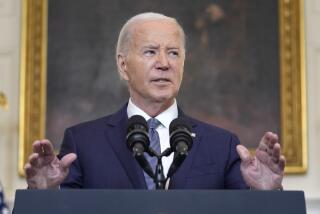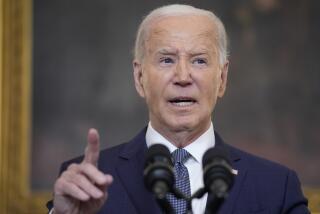U.S. May Let Groups Travel, Do Business in Vietnam : Diplomacy: Washington presents a âroad mapâ for normalizing ties. It is contingent upon help with a peace settlement in Cambodia.
WASHINGTON â For the first time, the Bush Administration is holding out the prospect that it may begin to allow American organizations to travel and do business in Vietnam.
In testimony to members of Congress on Wednesday, Assistant Secretary of State Richard H. Solomon described a detailed âroad mapâ for normalization of U.S.-Vietnamese ties--contingent upon Vietnamâs help in bringing about a peace settlement in Cambodia.
Under the plan, which Solomon also outlined in a private meeting Tuesday with a Vietnamese diplomat, U.S. veteransâ organizations and business groups could travel to Vietnam as soon as Hanoi and the Vietnam-backed government in Phnom Penh sign a Cambodian peace accord.
Gradually, in stages after that, the United States would lift its trade embargo, restore diplomatic relations with Vietnam and clear the way for the Vietnamese to obtain international loans.
At the moment, individual Americans can travel legally to Vietnam. With rare exceptions, however, they have been allowed to go only under the sponsorship of some non-American organization.
âWe believe that a new page of history could soon be turned in Indochina--that we can enter a period of political reconciliation and national development,â Solomon said Wednesday. Until last summer, U.S. policy was aimed at keeping Vietnam in both diplomatic and economic isolation.
The new Administration proposal is an attempt to break the current diplomatic deadlock over Cambodia. Both Hanoi and Phnom Penh are resisting a peace plan under which U.N. officials would take effective control of the country, supervise a cease-fire in the Cambodian civil war and conduct elections for a new government.
The U.S. initiative also represents an effort to counter the continuing criticism that by opposing the present government in Cambodia, American policy may unintentionally help the Khmer Rouge to return to power. More than a million Cambodians died when the Khmer Rouge brutally governed the country from 1975 to 1978.
The Khmer Rouge gets its arms and other supplies from China. The United States has given money to two non-Communist resistance groups, one of which is headed by the former Cambodian ruler, Prince Norodom Sihanouk.
The Administration has said it opposes any return to power in Cambodia by the Khmer Rouge. However, U.S. officials have acknowledged that at least some non-Communist military units may have cooperated on the battlefield with the Khmer Rouge against the Cambodian government.
Because of this, the Administration recently held up new U.S. aid to the non-Communist groups.
Both Vietnam and the Phnom Penh government headed by Premier Hun Sen have said they object to a U.N. peace plan because it would require the Cambodian government to transfer sovereignty to foreigners. They also fear that the Khmer Rouge could use the U.N. plan as a vehicle to regain control of the country.
Solomon told Congress that the Administration favors âa strong and mobile U.N. military presenceâ in Cambodia to rein in the Khmer Rouge. But he rejected the Hun Sen regimeâs complaints about a possible loss of sovereignty.
âWe firmly believe that Cambodiaâs sovereignty resides with the people--not with a regime established through foreign invasion and occupation,â he told Congress. Vietnam invaded Cambodia at the end of 1978 to dislodge the Khmer Rouge and install a new government in Phnom Penh.
Meanwhile, the State Department said the senior U.S. diplomat in Laos met for about two hours recently in Vientiane with Cambodiaâs ambassador to the neighboring Southeast Asian nation, a rare contact between the two countries, which have not had diplomatic or trade relations for 16 years.
As outlined by U.S. officials, the four-stage Administration initiative offers Vietnam and Cambodia specific, detailed economic and diplomatic rewards for complying with each of the steps necessary for a Cambodian peace settlement.
* First, as soon as the two governments sign an international peace accord on Cambodia, the United States would allow American business and veteransâ groups to travel to Vietnam, clearing the way for Vietnam to expand its foreign-exchange earnings from tourism. The United States would allow Vietnamese diplomats in New York City to travel beyond the 25-mile limit to which they are now confined.
* Next, as soon as U.N. officials arrive in Cambodia and arrange a cease-fire in the civil war, the United States would end the trade embargo against Cambodia and start to lift the longstanding trade embargo against Vietnam.
* After another six months, if all Vietnamese troops and advisers were removed from Cambodia, the United States would end the trade embargo against Vietnam and would ease U.S. opposition to loans by the World Bank, the International Monetary Fund and other international financial institutions. The United States also would support establishment of diplomatic offices in Washington and Hanoi.
* Finally, after elections in Cambodia and the opening of a new National Assembly, the United States would clear the way for a full resumption of all diplomatic and economic relations. It would also give its full backing to international lending to Vietnam.
In addition, at each step in this process, Vietnam would have to make progress in accounting for Americans still listed as missing in action during the Vietnam War.
To a certain extent, the Administrationâs initiative merely adjusts U.S. policy to what is already happening. Over the last two years, foreign business executives and tourists have been traveling to Indochina. Foreign companies trade there, and American firms would like to follow suit.
However, analysts agree that Vietnam needs the economic boost that would come from new international loans and the lifting of the U.S. trade embargo. The U.S. initiative holds out the prospect of these benefits as a reward for a Cambodian peace settlement.
More to Read
Sign up for Essential California
The most important California stories and recommendations in your inbox every morning.
You may occasionally receive promotional content from the Los Angeles Times.










